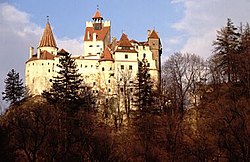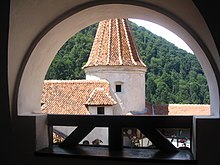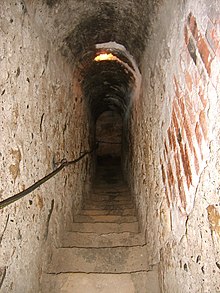| Revision as of 12:51, 5 December 2007 editGalaad2 (talk | contribs)155 edits Undid revision 175903909 by 121.210.200.87 (talk)← Previous edit | Revision as of 15:11, 5 December 2007 edit undoNergaal (talk | contribs)Autopatrolled, Extended confirmed users, Pending changes reviewers48,094 edits →"Dracula's Castle"Next edit → | ||
| Line 16: | Line 16: | ||
| =="Dracula's Castle"== | =="Dracula's Castle"== | ||
| ], who fashioned portions of his character ] from ], allegedly used Bran Castle as his model for ]. Bran Castle was subsequently featured in multiple film adaptations of "Dracula," and has informally become known as "Dracula's Castle." The local economy has made use of the connection to boost tourism; a small market exists at the castle gates selling souvenirs related to Dracula and ]s. | ], who fashioned portions of his character ] from ], allegedly used Bran Castle as his model for ]. Bran Castle was subsequently featured in multiple film adaptations of "Dracula," and has informally become known as "Dracula's Castle." The local economy has made use of the connection to boost tourism; a small market exists at the castle gates selling souvenirs related to Dracula and ]s. | ||
| ==Overview== | |||
| Looming ominously in the shadow of Mt. Bucegi, Castle Bran is a dark and gloomy edifice towering over a bed of stone - a gruesome though beautifully preserved fortress, straight from an Edgar Allan Poe story. Bran was a trading point during the middle ages; now it's claimed this was the castle of Vlad Tepes, but in fact his castle lies in ruins farther west in Transylvania in the Arges Valley. Tours are availabe through the castle. In the parking area there is a market where local peasants sell handwoven sweaters and other crafts. | |||
| BRAN CASTLE, Situated at 30 Km from Brasov, between the Bucegi and Piatra Craiului Mountains, Bran Castle is an important national monument and landmark of the Romanian tourism, due not only to the beauty of the Castle and the landscape but also to the legend of Count Dracula. | |||
| ==History== | |||
| The first documentary attestation of the Bran Castle is the act issued on November 19, 1377, by Ludovic I D'Anjou giving the inhabitants of Brasov the privilege to build the Citadel "on their own work and expense"... In exchange for this, the king confirmed the subordination of 13 localities to Brasov town and conferred the leadership of Bran Fortress to a lord of a castel who had also jurisdictional attributions. The permanent garrison was numerically restrained to 12-24 soldiers: archers and ballisters. Between the years 1419-1424 the Fortress returned in Sigismund's possession. | |||
| At the end of the XV-th century, the Bran Fortress was subordinated to the authority of the Szeklers Committee, responsile for the defene of the Sout-East of Transylvania, and since the reign of Iancu of Hunedoara, the Fortress passed under the rule of the Voivode of Transylvania. | |||
| On December lst, 1920, the Brasov Town council donated the Bran Castle to Queen Marie of Great Romania, as a symbol of gratitude for her contribution to the achievement of the "Great Union" of 1 December 1918. | |||
| Between 1920-1927, the Bran Castle was restored under the guidance of the Royal Court architect, Carol liman. He transformed it into a beautiful summer residence, surrounded with a park, fountains, a lake, walking alleys and halt terraces and built the "Tea House" Of Queen Marie. In 1938 Queen Marie left with will the Bran Castle to her daughter, Princess Ileana. | |||
| After the expulsion of the royal family from the country in 1948, the Bran Castle became the property of the Romanian State, being abandoned and ravaged for a period. Since 1956 the Castle was opened as a museum of history and feudal art. Being in a serious degradtion, a new restoration process of the Castle starded in 1987. The repair, by and large was finished in 1993. The conclusive museistic organization will be done taking into account new criteria, result of the researchers from the last years. | |||
| ==See also== | ==See also== | ||
Revision as of 15:11, 5 December 2007
This article is about Bran Castle, known commonly as "Dracula's Castle". For the stage show, see Castle Dracula.




Bran Castle (Template:Lang-de; Template:Lang-hu), situated near Bran and in the immediate vicinity of Braşov, Romania, is a national monument and landmark. The fortress is situated on the border between Transylvania and Wallachia, on Highway 73. Commonly known as "Dracula's Castle" it is famous as the home of Bram Stoker's Dracula, which has led to persistent myths that it was once the home of Vlad Ţepeş, ruler of Wallachia. While Vlad Ţepeş did not actually live in the Bran Castle, it is believed he spent two days locked in the dungeon while the Ottomans controlled Transylvania. The castle is now a museum open to tourists, displaying art and furniture collected by Queen Marie. Tourists can see the interior individually or by a guided tour. At the bottom of the hill is a small open air museum park exhibiting traditional Romanian peasant structures (cottages, barns, etc.) from across the country.
History
Bran Castle was originally built as a stronghold by the Teutonic Knights in 1212. The first documentary attestation of Bran Castle is the act issued by Louis I of Hungary on November 19, 1377, giving the Saxons of Kronstadt (Braşov) the privilege to build the Citadel. The castle was first used in 1378 in defense against the Turks, and later became a customs post on the mountain pass between Transylvania and Wallachia. The castle briefly belonged to Mircea the Elder of Wallachia. From 1920, the castle became a royal residence. It was the principal home of Queen Marie, and is decorated largely with artifacts from her time, including traditional furniture and tapestries that she collected to highlight Romanian crafts and skills. It was inherited by her daughter, Princess Ileana, and was later seized by the communist regime after the expulsion of the royal family in 1948.
In 2006, the Romanian government returned the castle to Archduke Dominic of Austria, Prince of Tuscany (known as Dominic von Habsburg, an architect in New York State), son and heir of Princess Ileana. In 2007, Habsburg put the castle up for sale for a price of £40 million ($78 million). On July 2, 2007, Michael Gardner, Chairman and Chief Executive Officer of Baytree Capital, the New York investment firm which has been retained to create a plan for the castle and to sell it, predicted it would sell for more than $135 million, but added that Habsburgs will only sell it to a buyer "who will treat the property and its history with appropriate respect."
In September 2007, an investigation committee of the Romanian parliament stated that the retrocession of the castle to Dominic of Habsburg was illegal, as it broke the Romanian law on property and succession.
"Dracula's Castle"
Bram Stoker, who fashioned portions of his character Count Dracula from Vlad the Impaler, allegedly used Bran Castle as his model for Dracula's Castle. Bran Castle was subsequently featured in multiple film adaptations of "Dracula," and has informally become known as "Dracula's Castle." The local economy has made use of the connection to boost tourism; a small market exists at the castle gates selling souvenirs related to Dracula and vampires.
Overview
Looming ominously in the shadow of Mt. Bucegi, Castle Bran is a dark and gloomy edifice towering over a bed of stone - a gruesome though beautifully preserved fortress, straight from an Edgar Allan Poe story. Bran was a trading point during the middle ages; now it's claimed this was the castle of Vlad Tepes, but in fact his castle lies in ruins farther west in Transylvania in the Arges Valley. Tours are availabe through the castle. In the parking area there is a market where local peasants sell handwoven sweaters and other crafts.
BRAN CASTLE, Situated at 30 Km from Brasov, between the Bucegi and Piatra Craiului Mountains, Bran Castle is an important national monument and landmark of the Romanian tourism, due not only to the beauty of the Castle and the landscape but also to the legend of Count Dracula.
History
The first documentary attestation of the Bran Castle is the act issued on November 19, 1377, by Ludovic I D'Anjou giving the inhabitants of Brasov the privilege to build the Citadel "on their own work and expense"... In exchange for this, the king confirmed the subordination of 13 localities to Brasov town and conferred the leadership of Bran Fortress to a lord of a castel who had also jurisdictional attributions. The permanent garrison was numerically restrained to 12-24 soldiers: archers and ballisters. Between the years 1419-1424 the Fortress returned in Sigismund's possession.
At the end of the XV-th century, the Bran Fortress was subordinated to the authority of the Szeklers Committee, responsile for the defene of the Sout-East of Transylvania, and since the reign of Iancu of Hunedoara, the Fortress passed under the rule of the Voivode of Transylvania.
On December lst, 1920, the Brasov Town council donated the Bran Castle to Queen Marie of Great Romania, as a symbol of gratitude for her contribution to the achievement of the "Great Union" of 1 December 1918.
Between 1920-1927, the Bran Castle was restored under the guidance of the Royal Court architect, Carol liman. He transformed it into a beautiful summer residence, surrounded with a park, fountains, a lake, walking alleys and halt terraces and built the "Tea House" Of Queen Marie. In 1938 Queen Marie left with will the Bran Castle to her daughter, Princess Ileana.
After the expulsion of the royal family from the country in 1948, the Bran Castle became the property of the Romanian State, being abandoned and ravaged for a period. Since 1956 the Castle was opened as a museum of history and feudal art. Being in a serious degradtion, a new restoration process of the Castle starded in 1987. The repair, by and large was finished in 1993. The conclusive museistic organization will be done taking into account new criteria, result of the researchers from the last years.
See also
External links
- Bran Castle Museum official website
- Dracula's Castle - fan website
- Pictures inside the castle
- Pictures of Bran Castle and the Bran Castle Museum
- Detailed instructions about how to get to Bran Castle — with estimated local travel costs
- Legend and the facts surrounding Romania's most famous castle
- Castelul Bran — picture gallery, related books, and articles
- Michael Gardner's biography on Baytree Capital's website
- Bran Castle - 360 Virtual Tour Travel destinations
45°30′39.91″N 25°22′11.75″E / 45.5110861°N 25.3699306°E / 45.5110861; 25.3699306
- Son stakes Dracula castle claim, BBC News, May 26, 2006
- "Vlad the unique selling point", The Daily Telegraph, January 6, 2007
- Alexandru Alexe, "Heir puts 'Dracula's Castle' for sale", Associated Press, July 2, 2007.
- http://www.realitatea.net/92626_Camera-Deputatilor--Castelul-Bran-a-fost-retrocedat-ilegal-.html